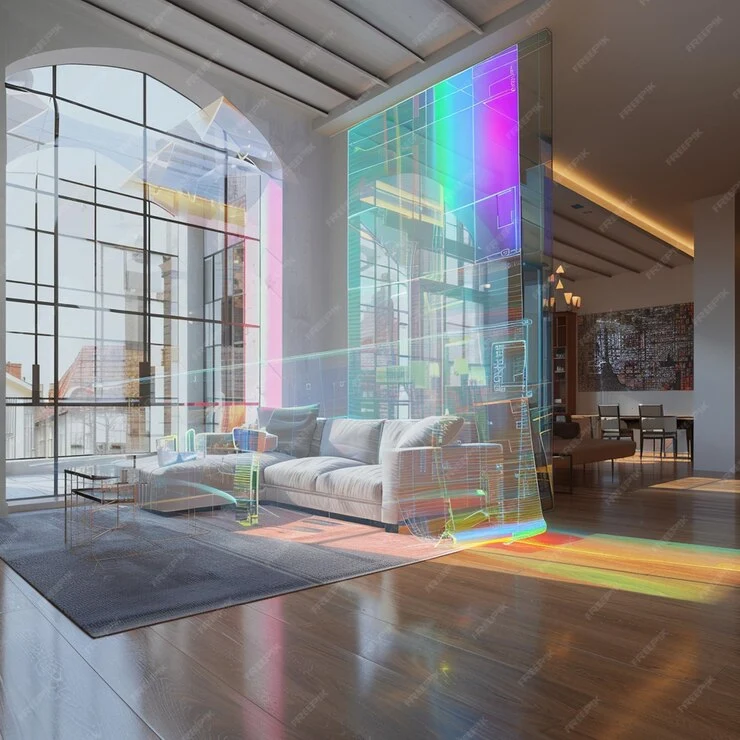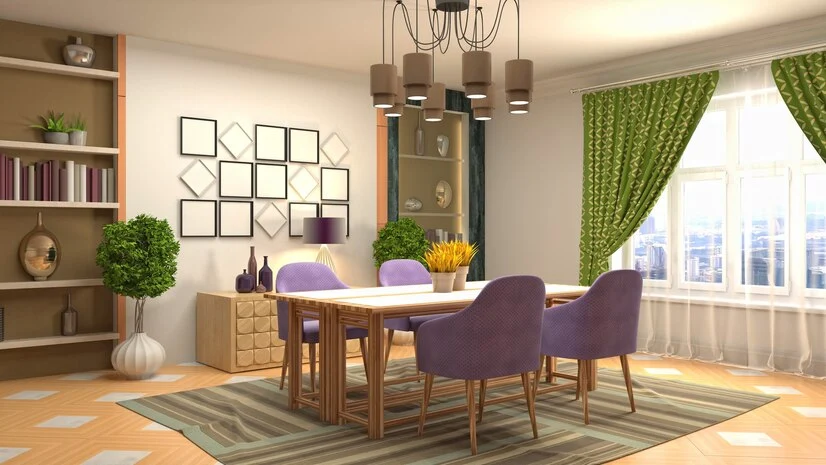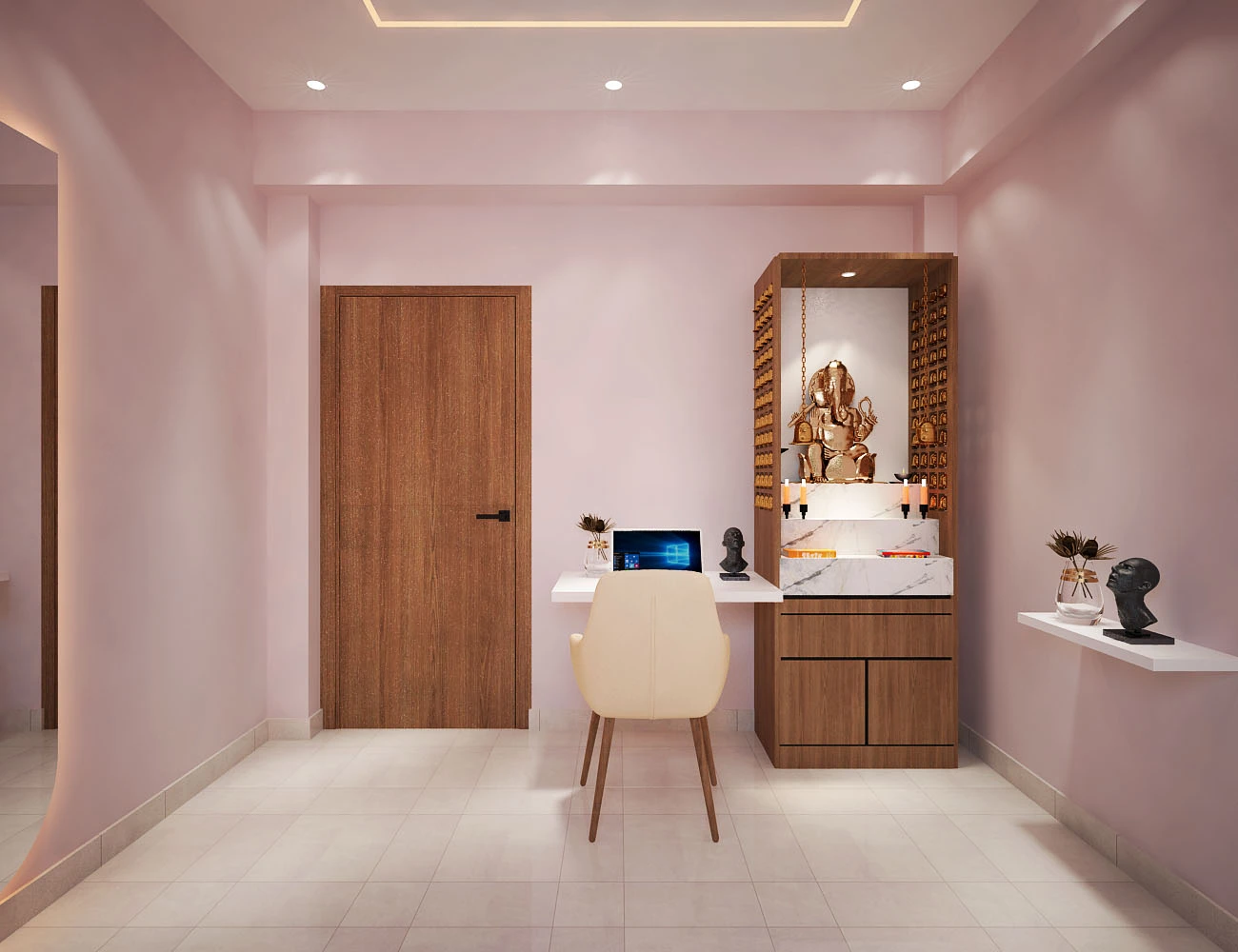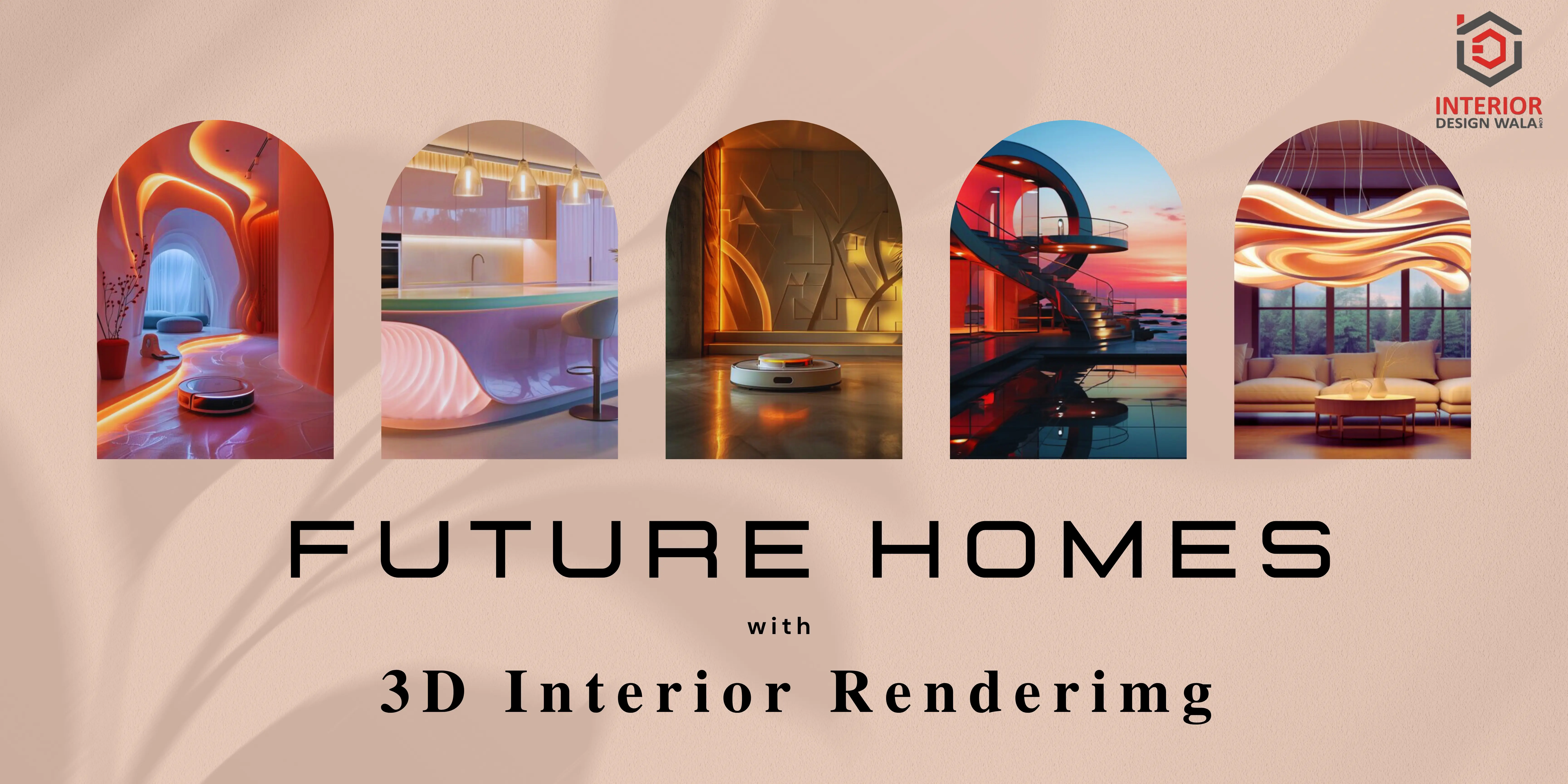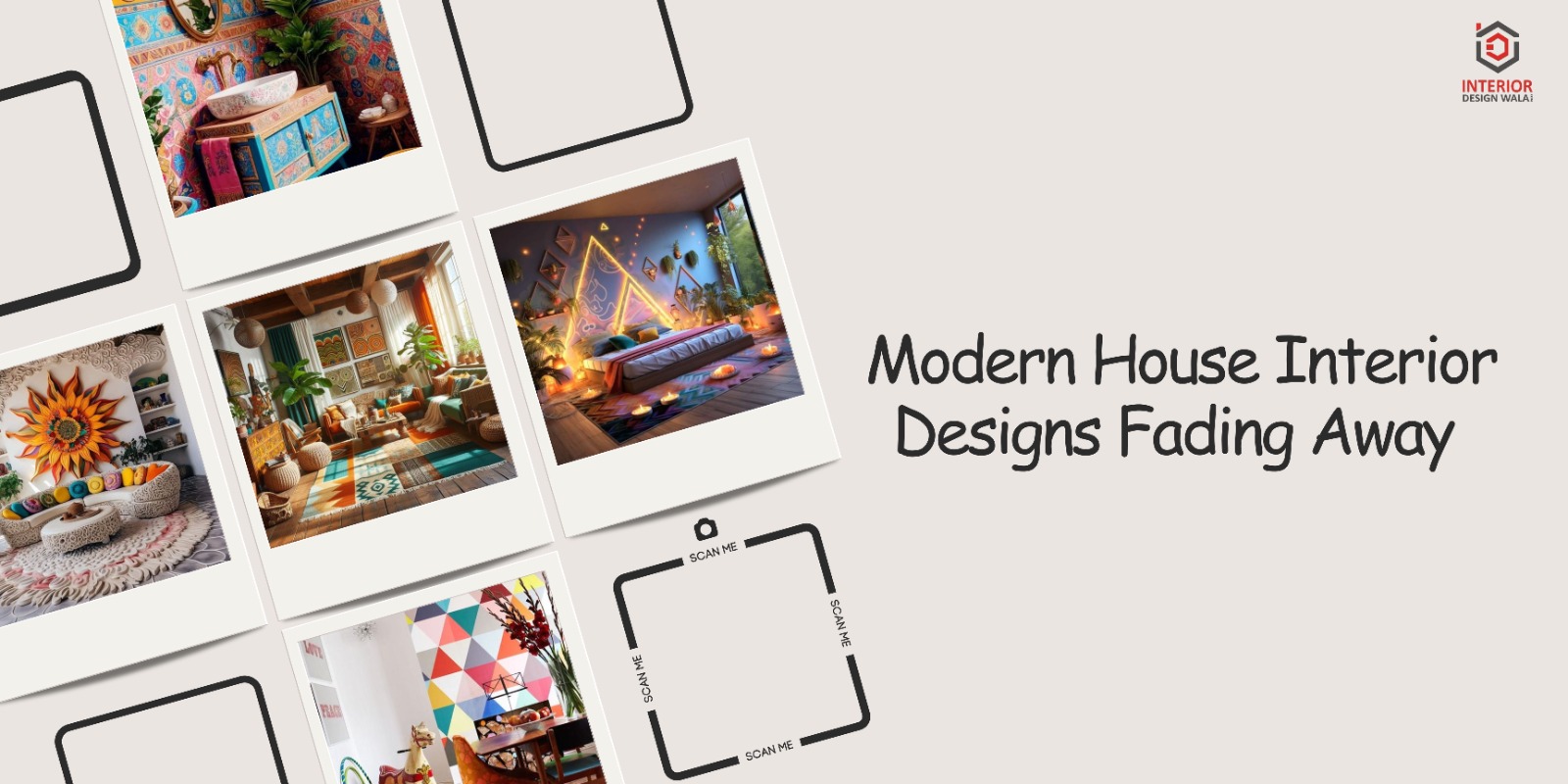E-53 Ground Floor, Sector-63, Noida
We will contact you soon with a responce.
We will contact you soon with a responce.
We will contact you soon with a responce.
3D rendering in interior design has changed a lot over some time since its inception. It has come forward with a long journey from making only simple images to creating realistic photos with the high level of detailing. 3D architectural rendering services have helped a lot in growing interior businesses with fine detailing, detailed space management, lighting etc. All these features help in making realistic images which help in better communication with clients, and better communication with references helps grow business. In this blog, we will explore new upcoming advancements in 3D rendering services that help in enhanced pre-visualisation experiences and what can be the futuristic possibilities in interiors with 3D design rendering.
The history of 3D design rendering dates back to 1963 when the father of computer graphics Ivan Sutherland invented Sketchpad. It was the first time that software could be used to draw and edit simple shapes.
1. Real-Time Rendering:
In real-time rendering, technological advancements have allowed to speed up the process of editing images. This technology also lets the designer utilise the real-time interaction of images with search engines such as Unreal and Unity. This is to enhance the user experience where the individual can walk through the design in any type of ambience and can experience the interiors from any angle.
How does it help?
Designers can showcase their sample portfolio with real-time interior rendering where they can showcase a real-like interior with a rich virtual experience with a variety of designs so that clients can experience the actual look of the interiors.
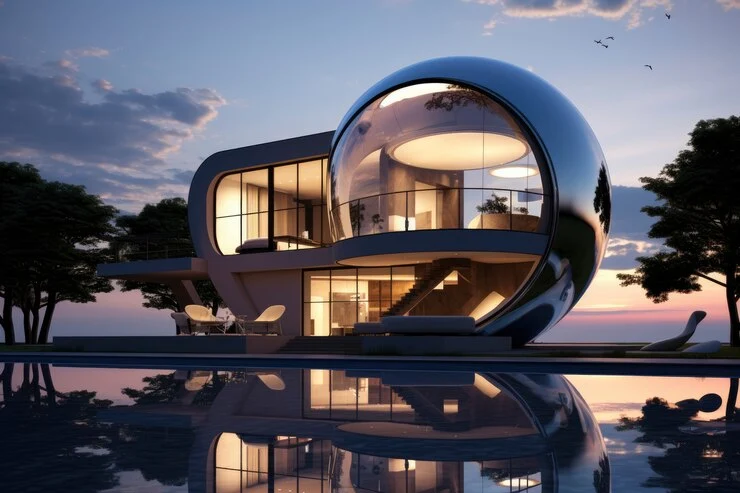
2. AI-Powered Rendering
In this type of 3D design rendering the use of artificial intelligence helps in meeting advanced goals in interior design. AI has brought revolutionary changes in the design industry. You can get on a plate what you can think of! So all you need is to understand your client's need and give prompts to AI-powered software. Thus, this helps in making quick design themes and interiors of the site. AI helps in making more accurate and realistic renderings with natural light simulators.
How does it help?
This rendering helps both ways. For designers to give a quick response to the design query and for clients to provide more accurate design references to designers for a better understanding of requirements.
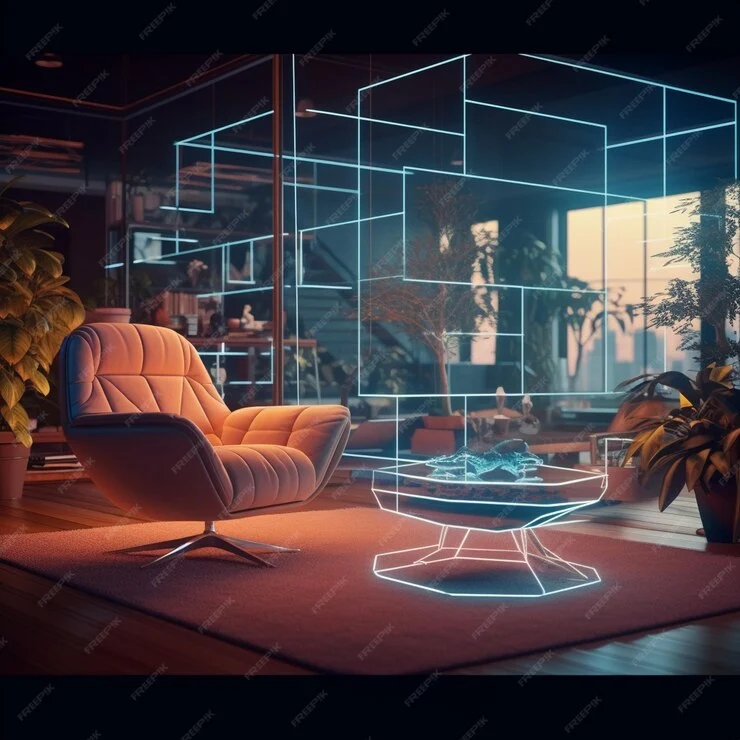
3. Extended Reality Applications
One most interesting techniques is the XR technique which ‘X’ stands for any variable/ any word of the alphabet that can blend the physical world with digital elements. It can be said that augmented reality, mixed reality and virtual reality are subsets of extended reality that allow clients to explore various 3D environments.
How does it help?
This helps in creating better simulations for any type of user. The client can access your designs while staying at their place, which in return helps the designer in making powerful client engagement and less chances of losing a client with the help of extended reality in 3D architectural rendering services.

4. Photorealism and Ray Tracing
What appears different in paper sketches and digital images? Do all digital/online images appear the same? What makes the images realistic? These are some questions that are answered by photorealism and ray tracing. Interior designers who use advanced 3D design rendering software can get the benefit of this inbuilt feature where the objects can get accurate shadows and reflections with tracing of the path of light in different materials and elements.
How does it help?
It helps in making realistic 3D images, in creating walkthroughs and in virtual reality where the whole thing is about feeling futuristic designs with technology.
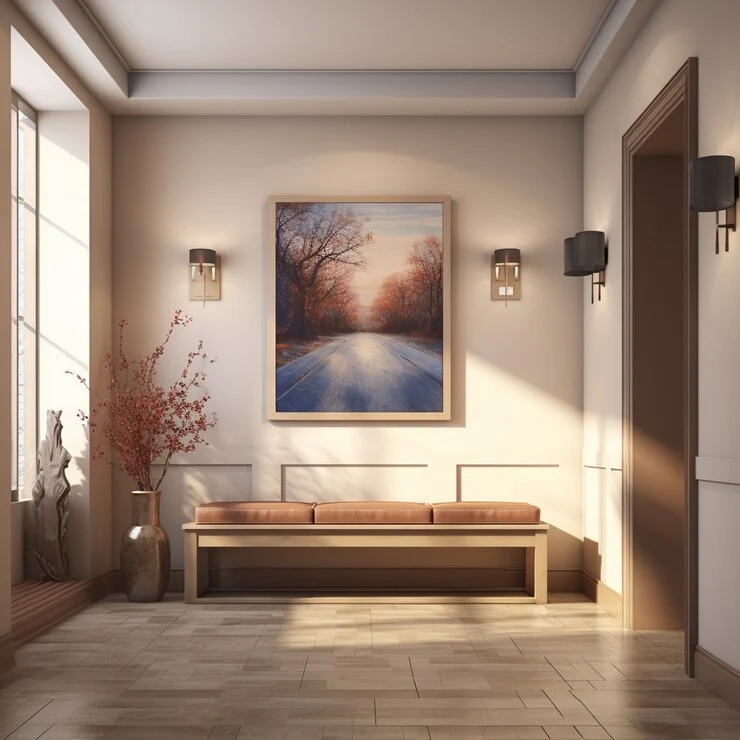
Take a look!!
A 360-degree view of interiors created with 3D rendering by Interior Design Wala.
5. Mobile and Cloud Rendering
If you want scalable, cost-effective and easily accessible 3D architectural rendering services but not on your local computer then cloud rendering is your option. This helps in increasing efficiency as multiple devices can work on the render at the same time.
How does it help?
This technology is used to speed up the tasks to free the local computers and enable it at remote locations so that the rendering can be done parallelly at several locations.
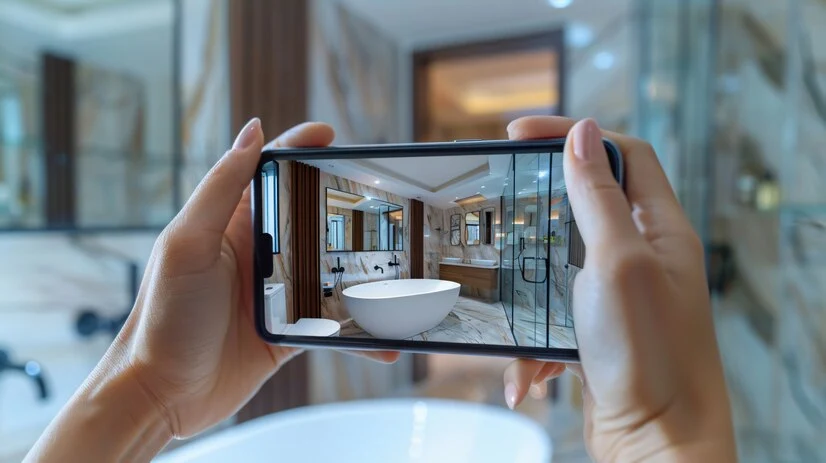
6. Holographic Rendering:
One of the most stunning 3D architectural rendering services that are going to be the future trend of interior design is the Holographic rendering technique. In this technique, 3D images are created in void spaces. This technique can be used as a great tool for placing furniture and objects in the interiors. However, the users of this technique are still fewer due to high-cost investment and less skill set, but as a futuristic approach, this can be a real path breaker in 3D design rendering.
How does it help?
This is the ultimate real-time experience of the interiors where you can see the future design elements live in your own space. Switching to this technique enhances customer satisfaction as they can see a holographic image of the futuristic design in their desired corner.
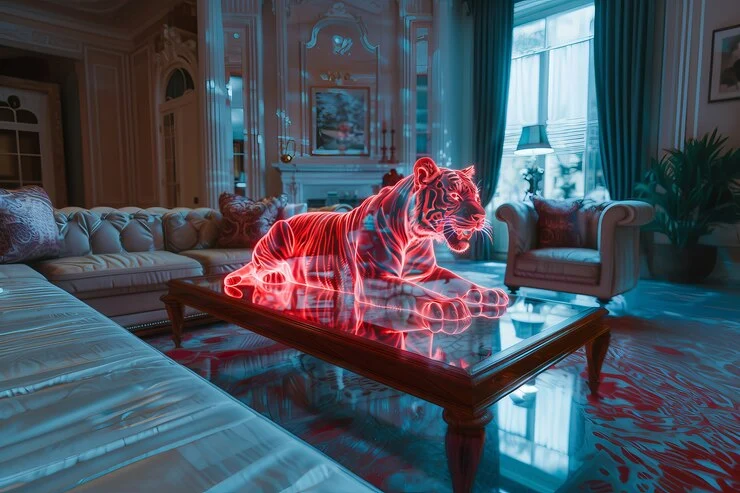
The Last Say
If we see it from an end user's perspective, one question will always come to our mind, i.e. ‘ but how will my interiors look like ?”. After all, when we talk about interiors it's all about the looks and feeling. Now it's the capability of the interior designer how he can bring richness to this ‘ look and feel’. It's only by giving the user that experience! These advanced technologies are the solutions for creating a rich experience for the user. Of course, there may not be every client who will be needing it but those demanding it can’t be ignored. They are the most aware clients who are ready to spend bucks provided the designer ensures them the quality work they provide.
This assurance can be provided by samples, brochures, and projects done in past by sharing 3D architectural rendering images of the user’s site. On top of it when designers use these advanced rendering techniques, it enhances the clarity of design to clients that are going to be part of life of their for years. So, interior designers if you want to grow your business start thinking about advancing in technology.
FAQs
Q1. Who is the best 3D architectural rendering services provider in interiors?
A. Interior Design Wala is one of the most trusted platforms in 3D architectural rendering services which works very keenly in detailing the images.
Q2. Can we have a 360-degree view of our interiors with 3D design rendering?
A. Yes. Interior Design Wala provides a 360-degree view of interior designs with its 3D design rendering services.
Q3. What is the cost of 3D rendering in interiors?
A. The cost of 3D rendering in interiors is variable according to the design complexity, the base price of the company and the built-up area of the space. You can get a free quotation at Interior Design Wala at 9315097751, drop a mail at bd@idwinteriors.com or simply visit www.interiordesignwala.com
Interior designing is all about how you can feel the designs. Many of you may even think ‘How can someone feel the designs?’ Yes! It's a matter of thought about why interiors are needed in any home. Is it a need or is it a luxury? In my belief, it's none of both. Infact it's not even a question of need or luxury. It is about incorporating an organised lifestyle. Interior designing contributes to leading the same. But what makes Interior designing more organised, well-communicated and deeply connected with the client? It's the technology behind it, i.e. the 3D rendered images.
Hadn’t it happened to you that you are awestruck by some interiors? A design that you feel completely belongs to you. Any home design image on Pinterest that you made your phone’s wallpaper or any interior designer's page on Instagram that you follow just because you like the beauty of images and designs created by them.
In modern times it is possible to give wings to your creativity with the help of technological advancements such as making 3D rendering images or 3D floor plan rendering images. All you need is a highly creative team that can foresee innovative designs and bring them to conceptualization in interior design. The design images created by professionals with conceptual ideas give some thumping outputs.
1. It gives an enhanced visualization of your imagination
Realistic Previews:
The 3D-rendered images of any interior design help in making realistic interiors with the help of technology. These realistic interior images in return help clients to have a better visualisation of the designs which they want to execute in real.
Detail Presentation:
These images bring a detailed virtual representation of the actual interiors that include lighting, furnishing, detailing with patterns, fabrics etc. So that the client can feel the designs before they are executed. These elements also minimise the gap between the actual site and virtual representation.

The software-based technology tends to provide a clear expectation to both parties i.e. the designer and the client. Showcasing the requirements with sample images and converting that precise design needs into reality with the help of 3D rendered images help in better requirement analysis.
Interactive Feedback:
Imagine yourself as a designer, explaining about a certain imagination of yours. You may think that you have explained the design very well to the client but when it's executed the client is furious about it!! What went wrong actually? The feedback!! Because the client was unable to visualise your imagination and thus give feedback on it. This kind of situation is well avoided by using 3D rendering.
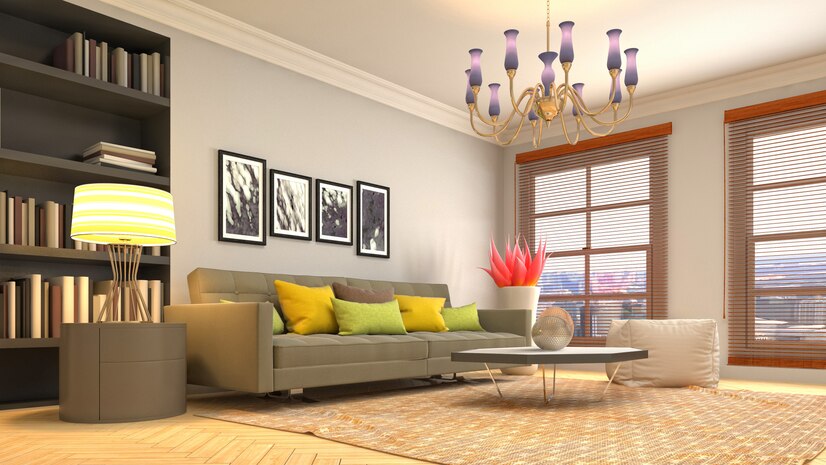
Compelling Marketing Materials:
Believe it or not! These images are a great tool for marketing your name. If you can create high-quality images and innovative designs then it's very much possible that your designs go viral over social media thus quality 3D rendered images are a great tool for making your presence in the competitive market.
Virtual Tours:
Virtual tours are very helpful in making your client ‘ feel the design’. This technology is again the next step of the 3D-rendered images where designers can give a realistic experience to the client with a 360-degree view. Interior Design Wala offers this service to its clientele base who wish to have a very precise and realistic view of the interiors before they are executed.
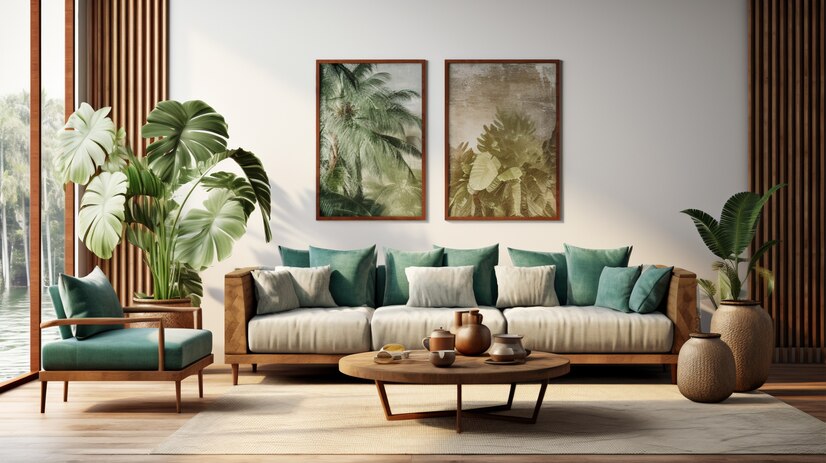
4. It certainly cuts down the time and cost of a project
Error Reduction:
3D rendered images are the perfect tool for saving time and energy. The possibilities of actual iterations on the site reduce with 3D rendered images. This activity before execution thus helps in error reduction in execution thus saving lots of time, energy and of course your bank balance.
Streamlined Approvals:
This technology has an emphasizing effect on meeting deadlines of the project and has lessened the timeline. However, it's an additional step in interior designing but this step is very fruitful in getting streamlined approvals, as with these clients get the best visualisation and if your work speaks, your projects can never get on a red tape.
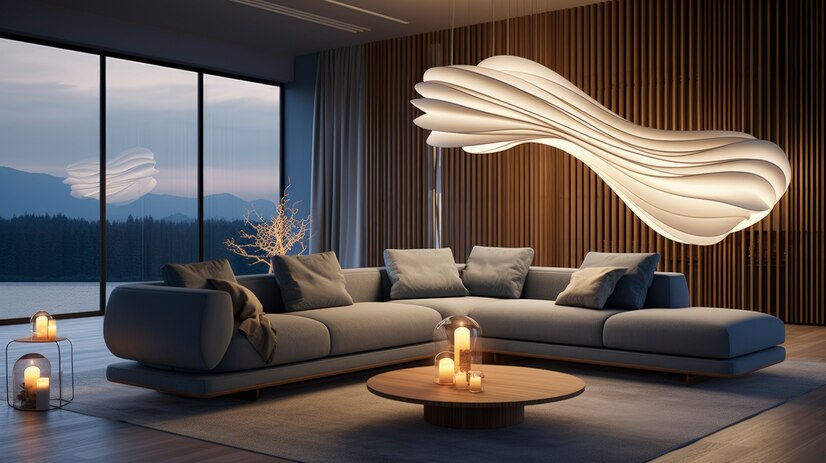
5. It helps you make a brand with a competitive edge
Innovative Approach:
3D rendering empowers the business with experimentation. In the modern world where every day we need something new for our’ feed’; this tool allows you to let your creativity fly higher and make it realistic and practical with your design approach.
Professionalism:
In the digital world, a sense of professionalism is achieved by making a great portfolio. 3D rendered images help in making this portfolio. It not only brings a streamlined approach but also showcases your professionalism and seriousness towards your business.
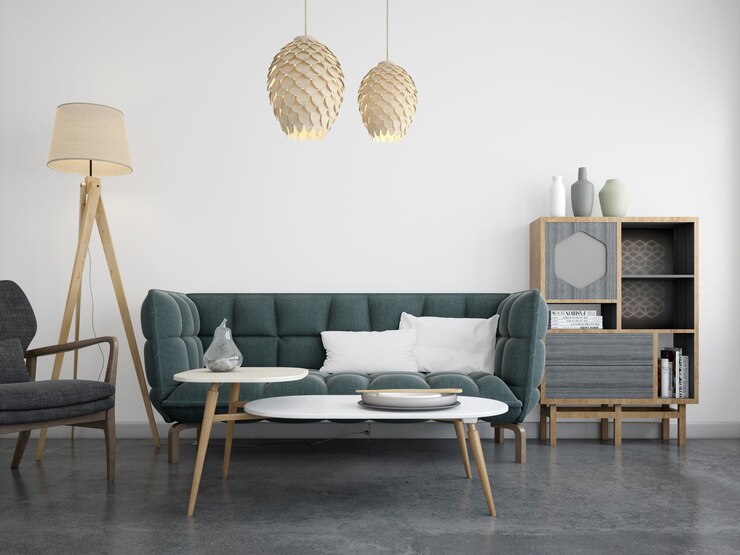
6. It helps in trust-building between clients and designers.
Increased Confidence:
A sense of trust-building happens when clients get to see your portfolio and your actual site execution. The less the difference between your designs and the actual site, it will make a lasting impact on client decision-making.
Enhanced Satisfaction:
No matter how great a designer you are, if you fail to satisfy your client, you will end up losing a project. Thus 3D rendered images are one means of the bridge where you just don't tell but ‘show and tell’. This again makes your work more comprehensible and satisfactory to the client.

The Last Say
Conclusively, it can be interpreted that if you are in a creative industry where your final product delivered is a completely executed site with all interiors and finishes; 3D rendering of creative ideas in the form of images and 360-degree visuals helps a lot in bringing growth to your business. Since trust building is a slow and elaborate practice it includes multiple things from engaging with clients, making stunning portfolios, taking your brand to the digital marketplace or even spreading awareness about your business by word of mouth, 3D images will always be a referral point in interior business. Thus, this tool is certainly very important in building an interior company or a branded company.
FAQs
Q1. Why 3D rendered images are preferred over photos?
Ans. Commercially, if we shoot a product costs more than doing rendering of images. Creating 3D-rendered images of a product is more cost-effective, and productive with the flexibility of designs for businesses
Q2. Where do we use 3D rendered images?
Ans. These images are used in every creative field as jewellery design, architecture, interior design, film making etc.
Q3. Which is the best software for 3D rendering?
Ans. Autodesk is the best 3D rendering software generally used by interior designers and architects.
.
Ideal place for pooja room
Bharat being a land of many cultures has also many religious beliefs. For example in Hinduism the north, east and the north est directions are considered best for making a pooja room due to the high positive energy of the rising Sun. In Islam, Qibla or the direction of Mecca is considered the most auspicious. Similarly in Christianity, the East direction is considered the direction of their almighty. Thus, as a professional interior designer, it is important to have in-depth knowledge of your client's backgrounds.
Technically there can be two types of pooja room designs i.e. closed and open. Where closed spaces are space-saving, compact and functional; the open pooja space provides an aesthetically pleasing area and allows large gatherings and detailed pooja space for pooja rituals, more privileged in Hinduism.
Closed pooja room designs for small spaces
Pooja room in the study room
If the study room doesn't have a toilet attached to it, you can make a small section for pooja in the study room. There can be various ways such as by making a temporary or permanent partition in the room, utilising the vertical walls for making pooja, you can also use blind corners of the room for making a pooja area by using wooden shelves, provided the corner is in the right direction.
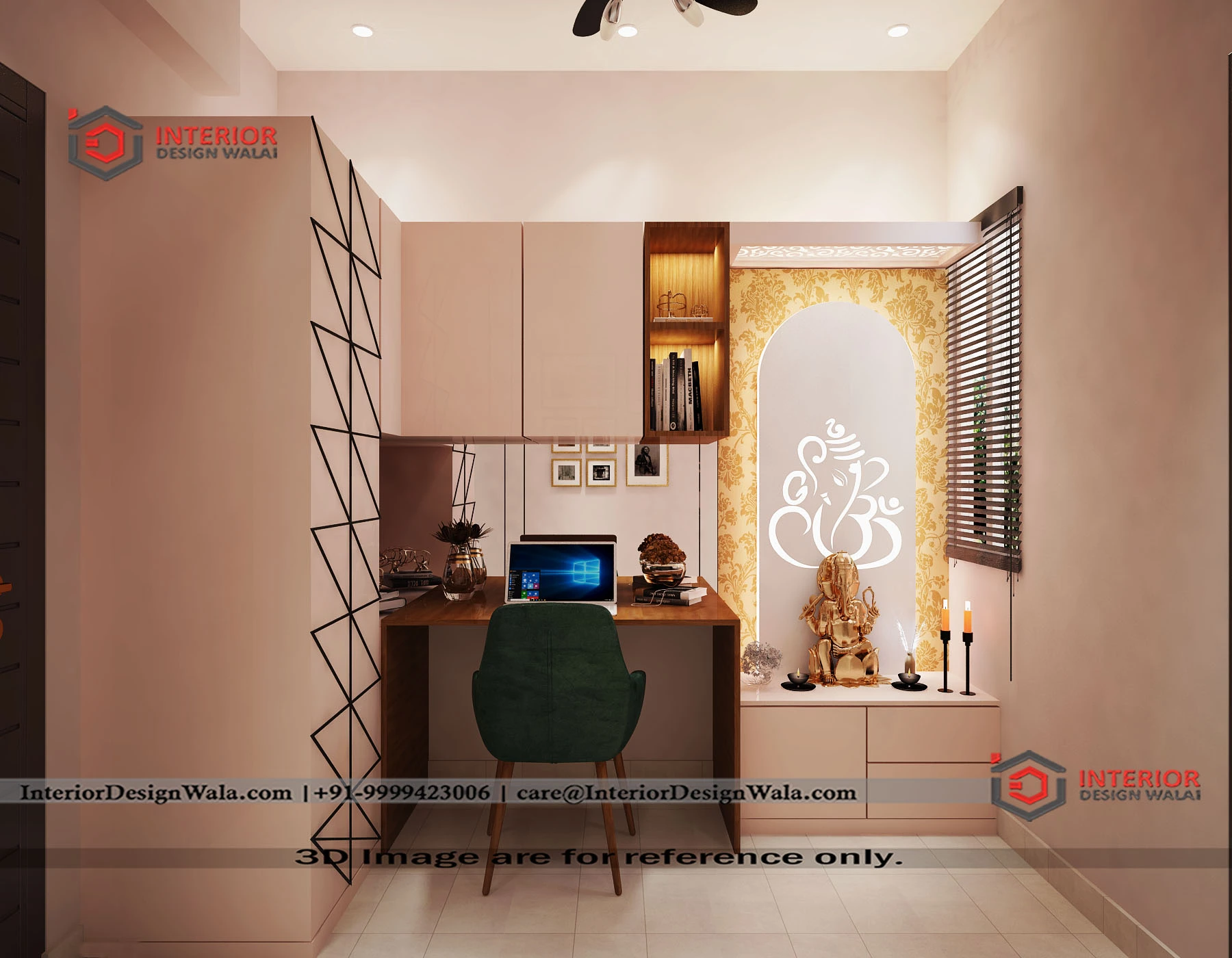
Pooja room in the bedroom
However, as per Vastu, it is advised to avoid making pooja in bedrooms, if it's unavoidable, make sure to give a solid/semi-solid partition in the room for making pooja room in bedrooms. You can also simply convert the balcony space into a closed pooja room.
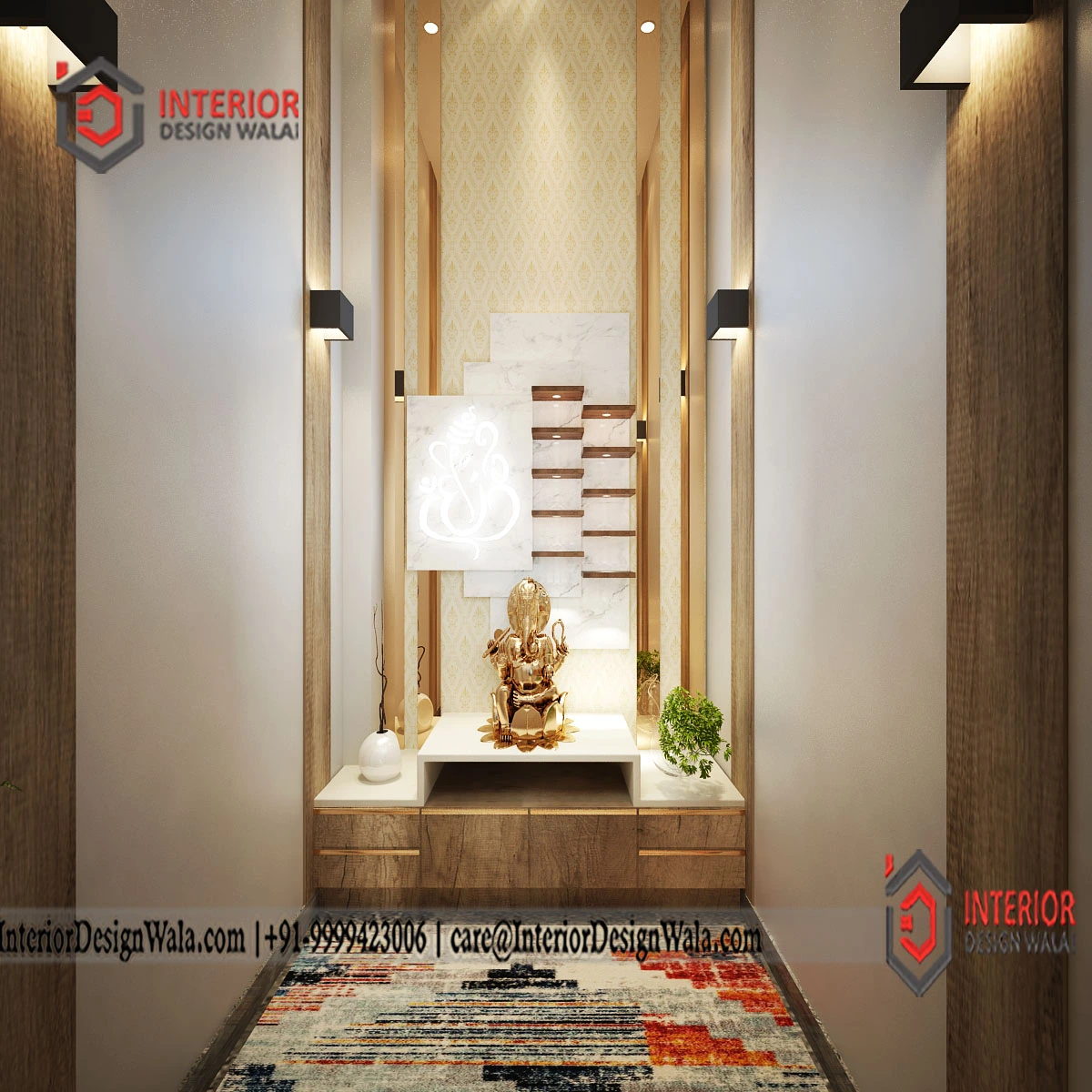
Open pooja room designs for big halls and common area
Pooja room in the living room
In the modern design system, where living space has become comparatively smaller than old days, making a pooja room in the living room is the new of blending modernness with traditional roots. You again try various options here, making an illusion of a closed partitioning hall, by placing a stylish earthen wooden temple etc.
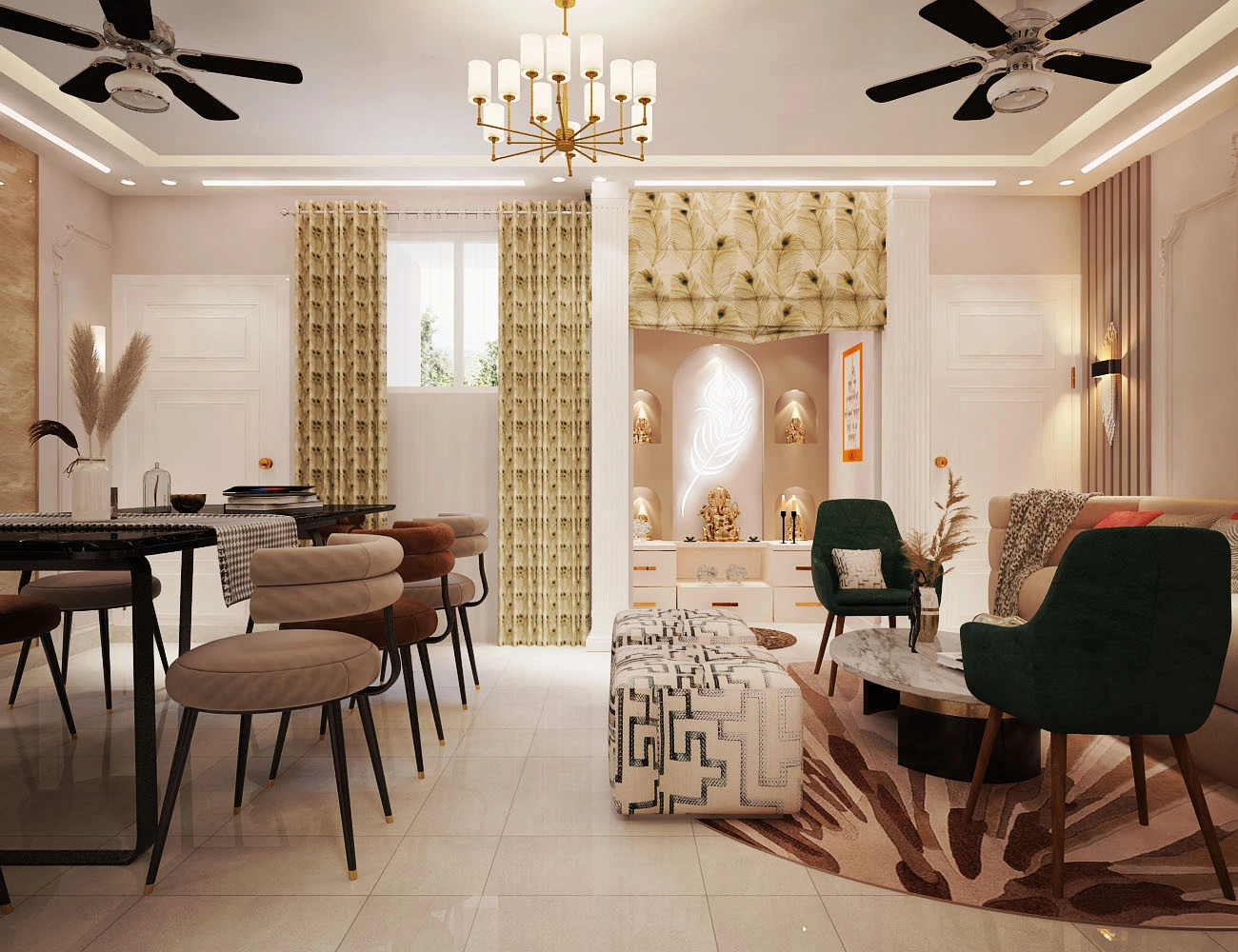
Pooja room in the accent wall of the dining area
One another place to make a pooja room is the accent wall of your dining area where you can make a dedicated space for a pooja mandir. This will be an open worship area which will also be aesthetically pleasing while dining in. If the direction allows so, making a pooja space near the kitchen is considered good in Vastu.
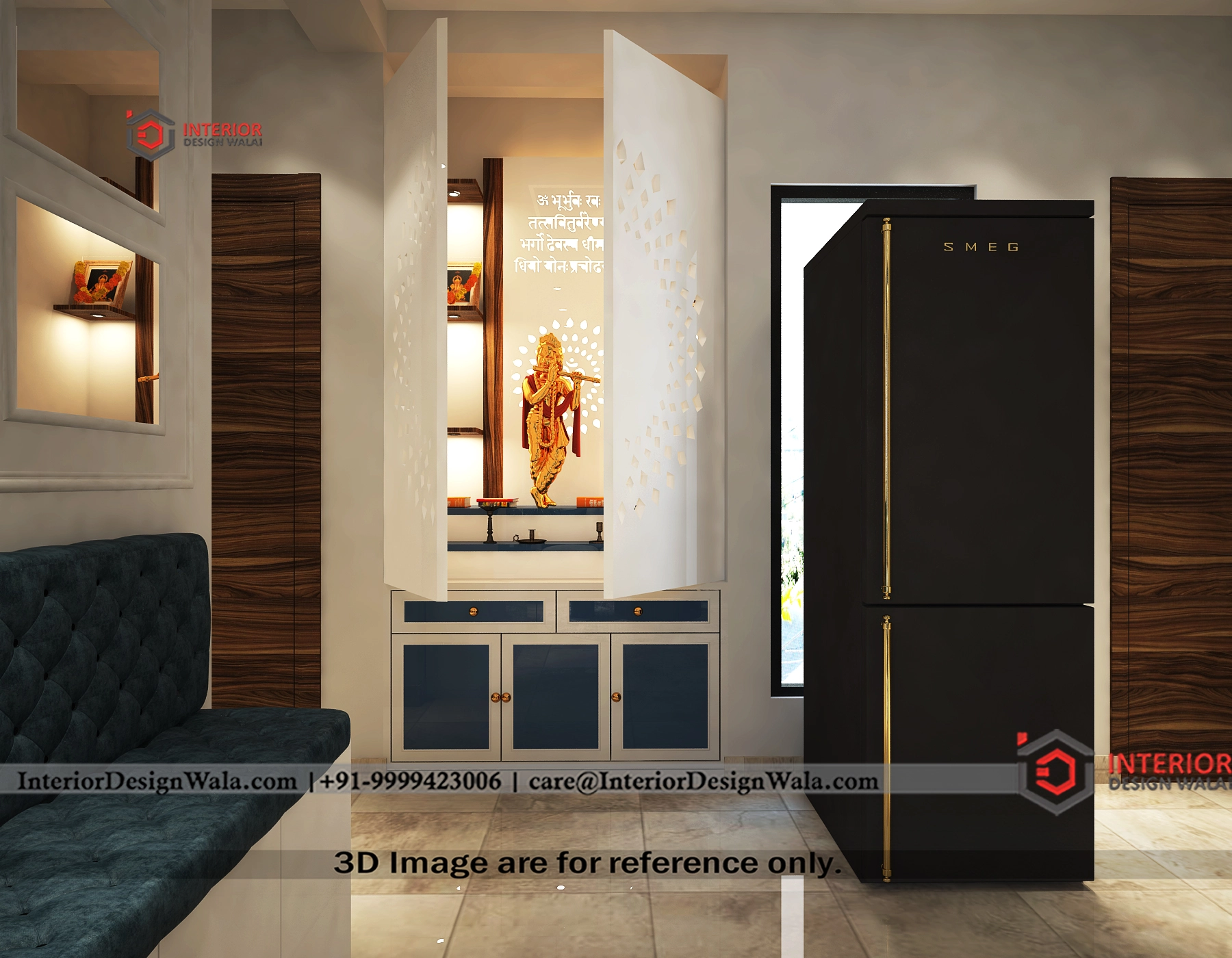
Pooja room being an inseparable part of Indian homes always needs special attention where you cannot compromise going with sub standards. Since it’s directly connected to the roots, identity and cultural existence of an individual it is advised to go for an interior design consultation with a professional such as Interior Design Wala, where they have expertise in blending cultural beliefs into modern styles while keeping the essence of the space intact.
Q1. Which is the ideal direction for making a pooja room or placing a pooja temple?
A. According to Vastu Shastra, your pooja room must be in the northeast direction of the house.
Q2. Which colours can be used in making a pooja room design?
A. Always look for soft and neutral colours for the pooja room such as beige, pale white, peach, cream yellow etc. These colours help in making high concentration.
Q3. What is the ideal shape of a pooja mandir design?
A. According to Vastu a wooden rectangular or square mandir with a pyramid on top is considered the best mandir design.
Q4. Which is the best material for mandir design?
A. Wood and natural stones like marble are considered best and pious for making mandir designs as suggested by interior design wala.
Are you overwhelmed with the social media images of interiors and design and think about how beautiful photography is it? Then you are wrong! Most of them all not real images! I also used to think the same way unless I was unaware of the 3D interior rendering technology. Software like Maxwell, V-ray, Blender etc are some common names for designers that help them give wings to their creativity and create beautiful interior images virtually. With this technology today we can give the desired ambience to any place with the 3D rendered designs (however its onsite execution is a different story). These are very useful in creating beautiful hallways, large mall spaces, thematic cafes, fun zones and lots more.
10 Images that Prove 3D Interior Rendering is Taking Creativity To the Next Level
1. Beautiful living rooms with 3D interior rendering
It should be noted that futuristic designs don’t mean they are impractical, instead, the functionality of the space is the utmost priority. The only difference is that it promotes the use of more innovative materials and unique designs that can increase the area's productivity, thereby enhancing the space's aesthetics.
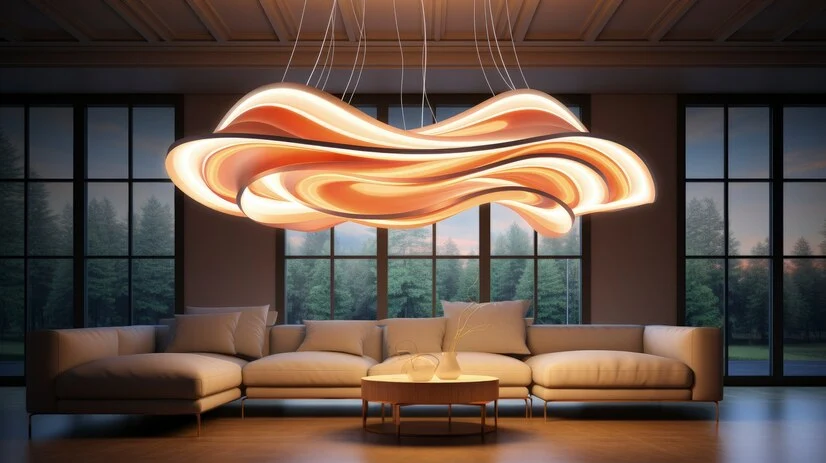
2. Making conventional bedroom designs
Interior designing is not only about decorating spaces, but it also helps in making comfortable and sustainable designs. 3D rendering helps in making more conventional designs that save energy and are closer to nature. For example creating skylights, giving abstract ceiling designs, lowline beds etc.
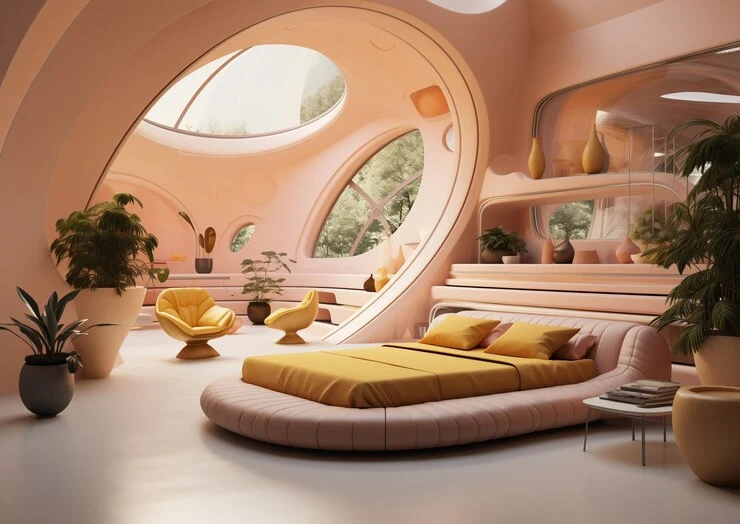
3. 3D exterior rendering services for facade landscapes
The rendering services create beautiful exteriors and make the facade or the elevations even more beautiful. The creative and abstract designs make the building look even more splendid from the street view and unknowingly make them a future reference point.
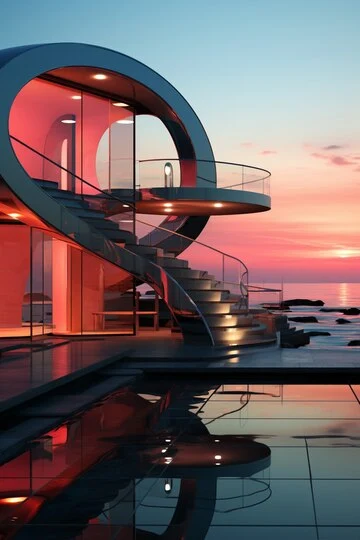
4. Biophilic bathroom designs for a soothing soul
Imagine you are spending your vacations under a splendid roof like this. How amazed will you be when you realise that this is not only the bathroom but a soothing place that is calming your soul? Yes! These types of designs are visualised by creative designers in their imagination and are visualized with the help of 3D rendering services.
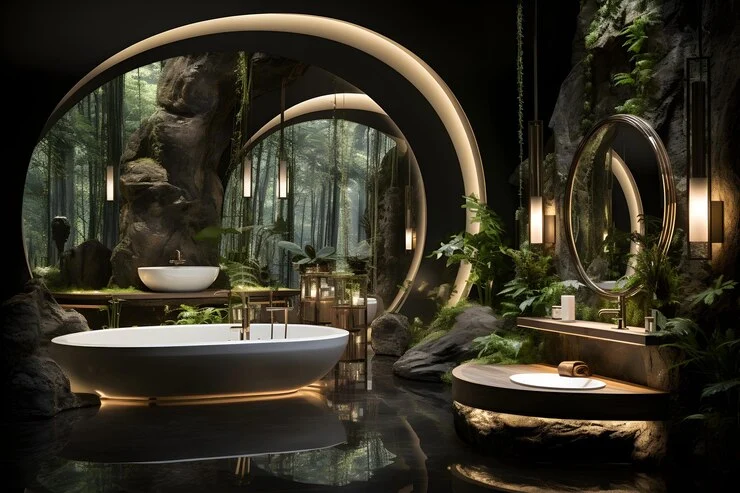
5. Feel the elegance right from the entrances with unique 3D designs
Even the entrances can be made so special with the help of 3D rendering. Often interiors are considered only workable inside of apartment or building. If you believe in the quote first impression is the last impression.
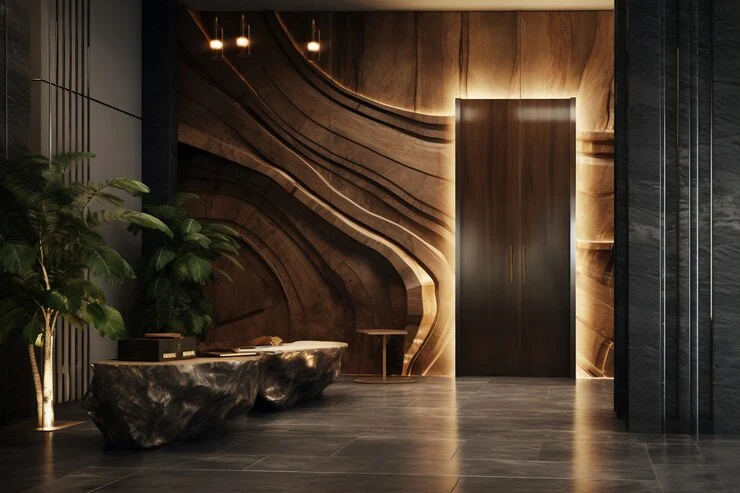
6. Making kitchens more functional and enigmatic
Kitchens! The heart of a house is often the most neglected place in terms of interiors. Many a time a reason is given that interiors in the kitchen create barriers in functionality. Thus, 3D interior rendering helps in creating segmentation of every space so that every corner can carry magic in itself.
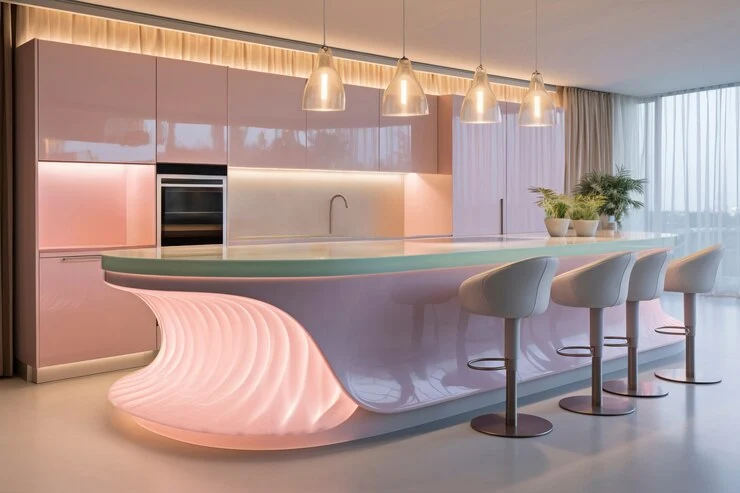
7. Office spaces like never seen before
Have you ever imagined in working office spaces like this? Just look at the beautiful false ceilings, types of furniture and colour scheme. All this is first visualised by a creative designer, then created a 3D model and then the 3D interior rendering is used to give real colours to the imagination.
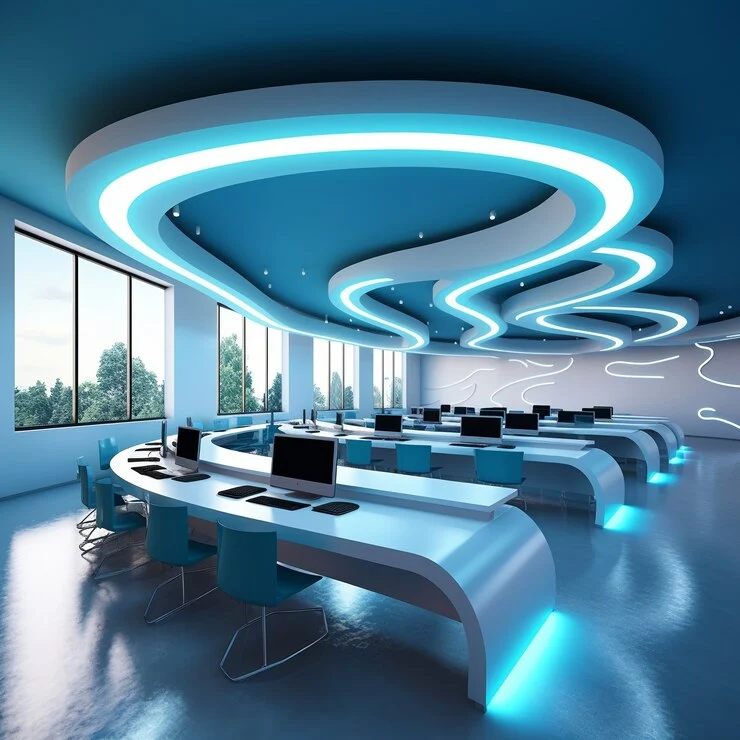
8. Intriguing 3D wall designs with 3D rendering
You give special focus to the desired area such as detailed wall art, with highlights of designer lights. You make a close-up view of the specified place for creating very minute detailings. The conceptualisation, design and idea are completely based on the imagination of the designer. However, bringing out that imagination on screen is done by 3D rendering of designs. This helps in creating exact interiors while executing the designs.
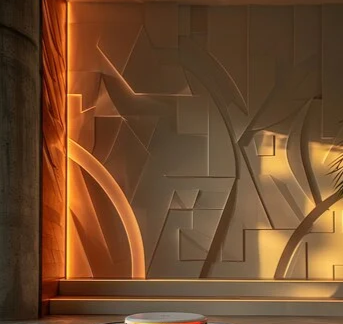
9. Transform your balcony spaces too
Open spaces like balconies, porches and courtyards can also be transformed beautifully with 3D exterior rendering services. One of the most important things to take care of in 3D rendering is paying focus on detailing, such as the depth creation, the shadows, showing materials just as they look, creating reflections etc.
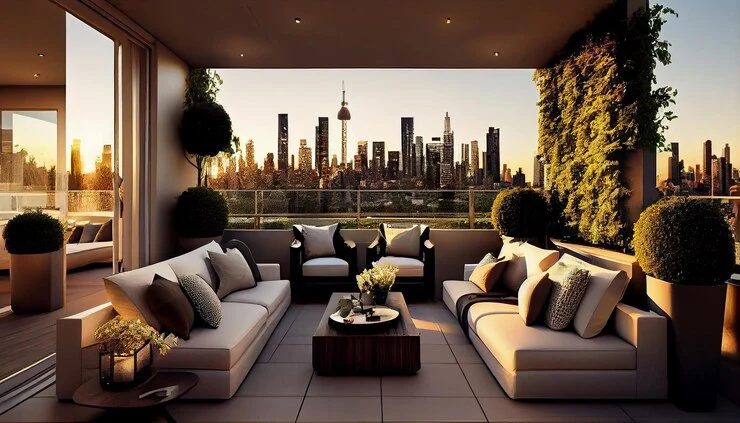
10. A lobby from another world
The lobby or the foyer of any building is the first impression of the building which needs to be well designed. With the help of 3D interior rendering, you can make your lobby area look like a beautiful space from another world of the universe. This type of design can also be used for making beautiful spa centres, hotels, and small cafeterias where ambience is the key role player.

The Last Say
These images are bringing the future of home interiors that may come true with the help of professionals such as Interior Design Wala. The out-of-the-box themes and designs also help in the discovery of new and innovative materials with which the designs can be converted into reality. Thus Interior design is no longer limited to art and designs, it has led the way to space management solutions, innovative design solutions, and sustainable materials that harmonise the ecosystem. With the help of 3D interior rendering, the designers can give wings to their creativity and simultaneously communicate with clients in a better way, which offers them
FAQ
Q1. Who is the best 3D interior rendering service provider in Noida?
Ans. Interior Design Wala is the best 3D interior rendering service provider in Noida.
Q2. How much does a 3D interior rendering cost?
Ans. The 3D interior rendering of a project depends on the size and complexity of the project.
Q3. What are 3D rendering services?
Ans. In 3D rendering services, the photo-realistic images of 3D models are created with various software tools.
Q4. What is the difference between 3D modelling and 3D rendering?
Ans. In 3D modelling, the objects and spaces are created with the help of 3D blocks while in 3D rendering the photorealistic images and animations of these spaces are created.
Is the Concept of Modern House Interior Designs Fading Away?When we talk about designing our home, what comes to our mind? What colors should we choose, and which design theme to go or? Which curtains to shop for and lots more? The most important among all these is choosing a theme for house interior designs. For the past four decades, western designs have been dominating the industry which was based on the concept of minimalism. It led to sleek, geometrical patterns, a neutral palette of colours and the use of soft tones in most of the houses. But, from the past 4-5 years this trend is making a shift towards new interior design concepts. These concepts have focussed on blending the two basic ideas– the increased functionality of the space and making warm vibrant spaces. In this blog by Interior Design Wala, we will learn about such themes that are continuously getting the love of people due to their fresh ideas rather than repetitive modern designs.
1. Choose Clutter Core Theme to Flaunt Your House Interiors
This is the brand new concept in interior designing which outrightly rejects the concept of minimalism. In this theme, the house is designed with maximalism i.e. flaunting the intricate designs, beautiful wall colours, lots of accessories and popping designs. So basically this focuses on making lively house interior designs. This is to be noted that these designs are implemented in such a way that this doesn’t hamper the functionality of the space.
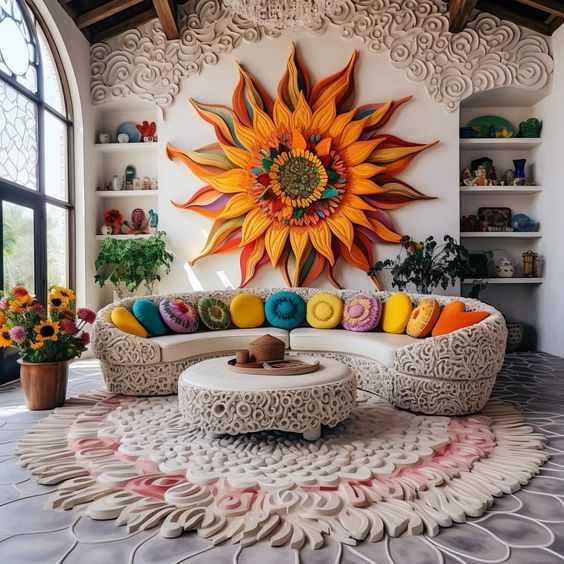
The bohemian theme have the concept of unconventional design themes that make the rooms look eye captivating and ad an element of focussed transition in the house. In a large room interior design it can include a large mural design, full wall art design etc. Use of colourful lights and abstract design art/ wall paintings.
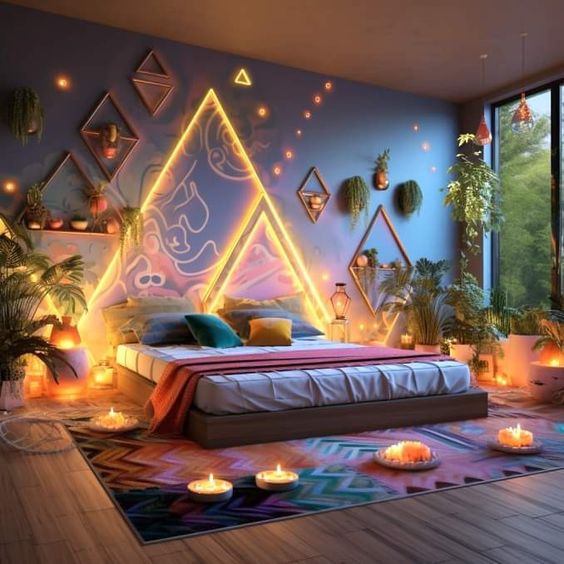
3. Eclectic Theme Out of the Box Designs
The eclectic theme is generally a mixture of designs that don’t necessarily fit with each other. This theme contains a wide variety of designs and ideas. You can choose to bring together various artforms, mixture of colours and varied textile prints on curtains, upholstery to make the pace look more vibrant and colourful.
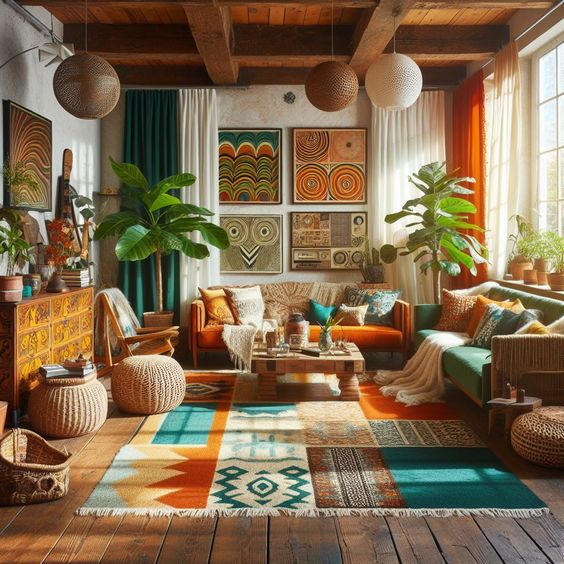
This theme bring back the royalty in houses as used to be in the old goldeen era of nobles. In India due to varied cultures, this theme becomes very important in terms of variety in homes. In contrast to modern theme, this include beautiful and intricate design patterns with carvings, mouldings, POP work etc. The bold colours, vintage lamps, royal chandeliers etc are an important feature in this type of interior theme.
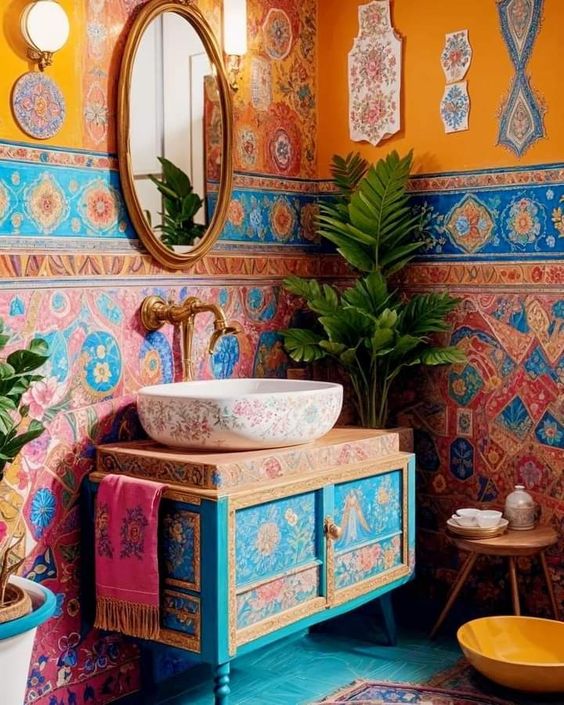
5 Ways to Use Colours Elegantly in Any Room Interior Design
1. Dynamic False Ceiling
If you can bring colours to your false ceiling , this is the most beautiful manner in designing a non modern thematic house. Choose to add colourful POP work, adding glass murals, coloured lightings in the grooves. In this type of wall design always cut the extra brightness of POP colour by adding white to the borders.
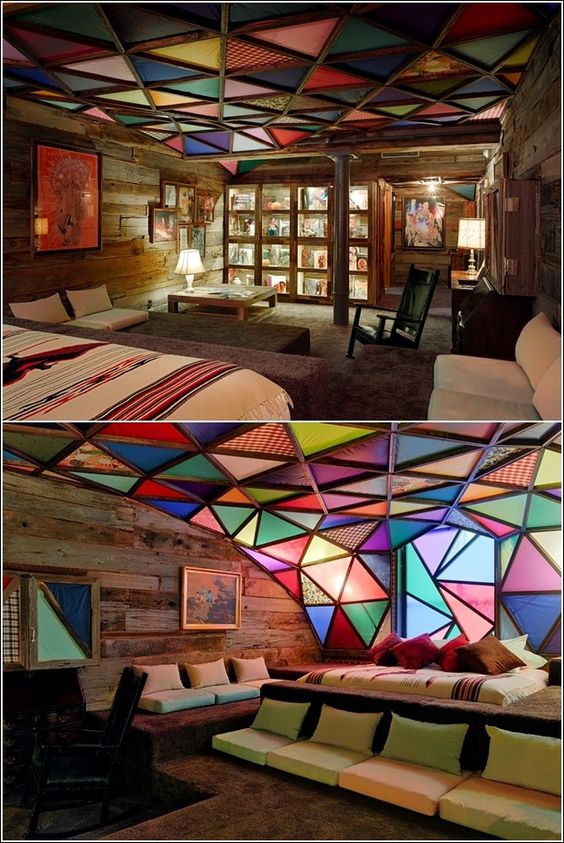
2. Curtains to Set Mood
One of the easiest way of adding colours to the your beautiful room interior design is by adding colourful, patterned curtains for your homes. The best part with this is you can eventually make changes in the colours an give a new look to the home everytime in avery budgeted manner.
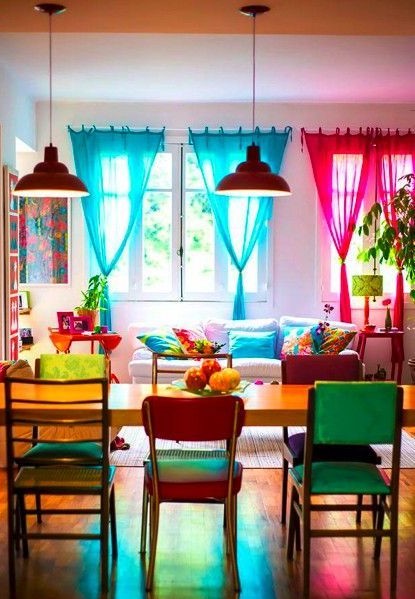
If you are choosing the above described theme, the furnitures play a very important role in this. You can play with a themetic fabric furniture for living room or play with, multiple colours in the dining room. Add patterned headdbacks in bedrooms.
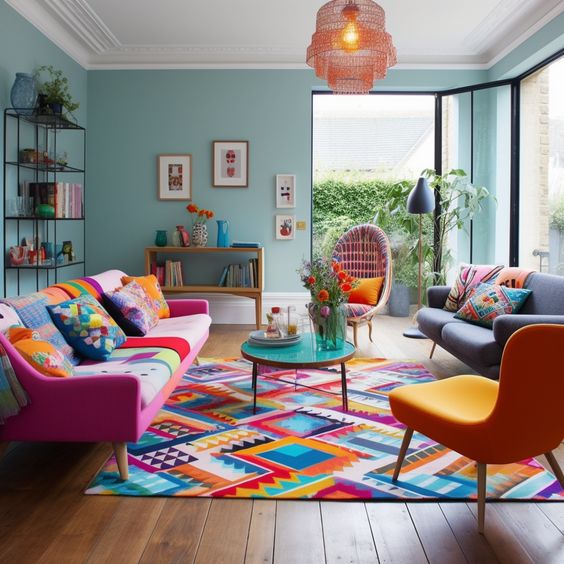
One of the most important object that bring vibrance and elegance at the same time in homes is the accent walls. These walls bring an aura to the homes when designed by a professional help such as Interior Design Wala.
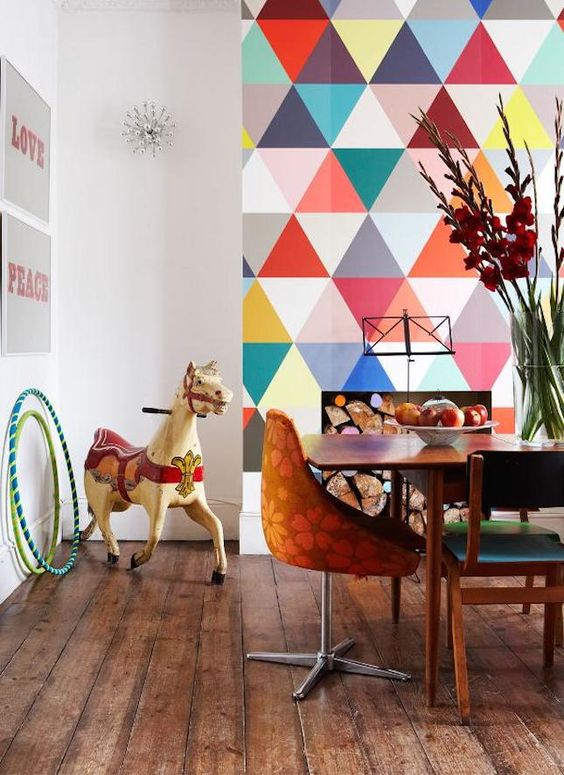
One of the smartest way of adding colour to any house interior design is by choosing colourful accessories and home decors for the space. This can include the decorative items, wall hangings, paintings, and even decorative lights.
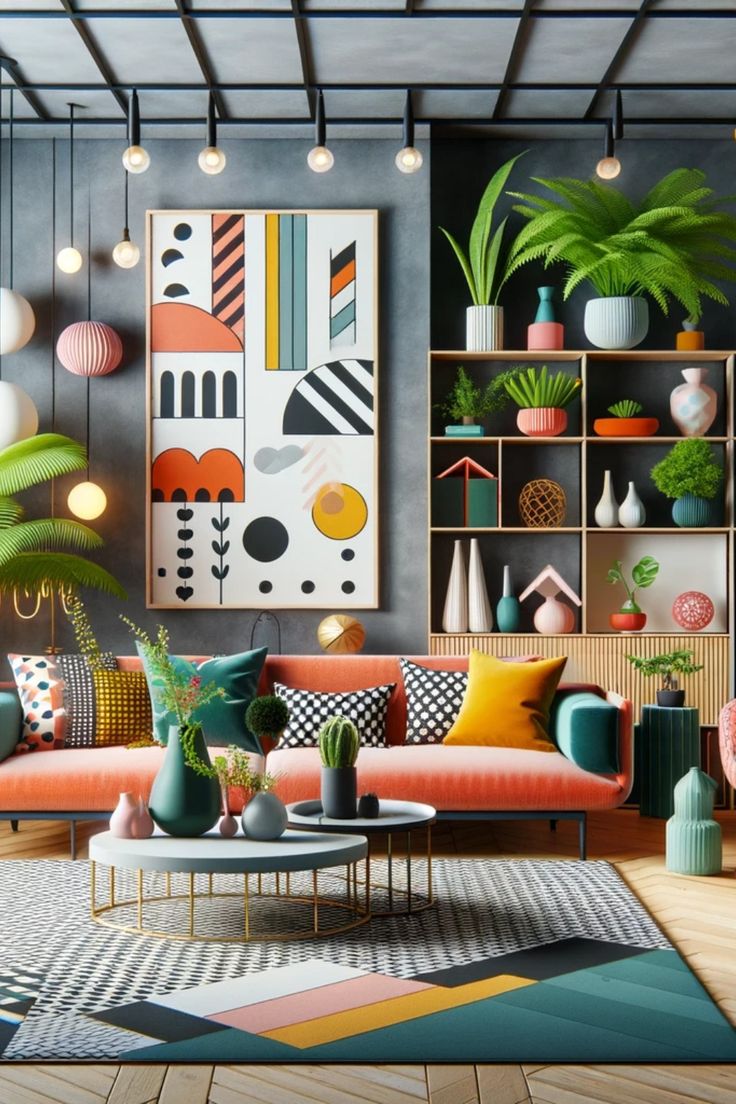
The Last Say
As we are living in an era of awakening of subconsciousness, in this era people tend to see their reflections in the house than what is more trending in the day. However, in this choice modern deigns can also make their special place but the this off beat trend is also getting popular and getting reonisiation among creative people specially. In the end, it's clear that the concept of minimalism or the modern house interior designs are undergoing a transformation, ushering in fresh and eye catching design concepts. If you get mesmerised by the design concepts of these dynamic, eclectic, and bold themes, you are switching over an era of minimalism. These trends offer an exciting departure from conventional minimalism.
Q: What are pop colours in Bohemeian Theme?
Ans: The colours that are fiery, vibrant or have high energy such as, red, yellow, pink, green etc.
Q: What is upholstery furniture?
Ans: This type of furniture means attaching a furniture frame with cushioning, padding and adding textile to the frames.
Q: Which is best interior designer in Noida?
Ans: Interior Design Wala is the best interior designer in Noida, Greater Noida, Ghaziabad for its eed to end execution and serving Pan India with 3D designs.
Q: What does a modern house interior design include?
Ans: The modern house interior design include symmetrical designs, linear/ geometrical patterns and neutral colour pallette.
E-53 Ground Floor, Sector-63, Noida
Turnkey Projects +91 99901 55566
Online Designing +91 93127 39997
CAREERS
care@interiordesignwala.com
We will contact you soon with a responce.

